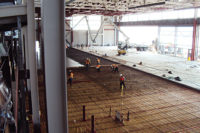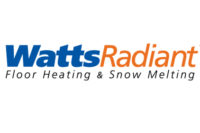When I was first introduced to the concept of radiant cooling, I am certain the very first thing that ran through my mind was, “But what about the condensation?” I also am certain that I am not the only person who had this same thought.
I had some negative mental images associated with open radiant floor heating systems: cold water flushes pushing cold incoming water through the radiant floor circuits in an effort to avoid fluid stagnation; the associated complaints of the residents of the building; and how cold the floors were during peak showering first thing in the morning.
Like many contractors, I was accustomed to seeing condensation pouring off the chiller piping and fan coil units used to convey the cooling to the final load. I kept thinking to myself, “But what about the condensation?”
However, I kept an open mind and followed the lead of my friend, Robert Bean, who was instrumental in the development of ASHRAE standards pertaining to human comfort. He also was instrumental in the development of standards by plastic tubing manufacturers in their efforts to move this fantastic method of delivering radiant cooling to the general public.
You see, Virginia, radiant cooling is no longer in a conceptual stage. It has been used in some of the most brutal cooling conditions and in some very visible buildings all around the world. As usual, it seems as though we Americans are slow to catch on to radiant trends that have been proven numerous times in numerous countries around the world for more than two decades.
An early example of commercial radiant cooling is the installation at the New Bangkok (Suvarnabhumi) International Airport in Bangkok, Thailand. This facility is in an extremely hostile cooling environment, with significant solar loads as well as high background humidity and internal latent (occupant) loads of around 12,000 passengers per hour. This application has proven that radiant cooling with the use of radiant floors can be done very effectively.
Sensible and latent energy loads
One key to utilizing radiant cooling is understanding the limitations of these systems. It is very important to reduce the loading of a given building in order to meet the building and occupant expectations. By reducing the solar gains through the use of external shading devices and intelligent glazing options, the loads can be reduced to a lower level so that the radiant cooling system and latent energy removal supporting systems can handle a significant portion of the combined sensible and latent energy loads.
If these sensible loads are not reduced through building design, then some temperature and humidity conditions may occur that are considered outside of acceptable comfort conditions during peak loading. In order to avoid these conditions of discomfort, an increase in the size of the required air-handling systems for both the sensible and latent loads can be expected. The math formulas have been tested and proven, and they must be run to ensure good human comfort.
My point here is to explain that radiant cooling is no longer a concept but is a much-proven methodology for reducing the energy requirements for providing human comfort during cooling conditions.
We’ve all experienced the quality of comfort associated with radiant heating systems. Radiant cooling is essentially adopting those same human comfort conditions, except it is on the opposite end of the comfort scale — the cooling mode instead of the heating mode. I’ve been saying for a long time now that the primary factor in delivering an excellent human comfort experience is controlling the mean radiant temperature. It applies to the cooling side as it does to the heating side.
In the course of explaining radiant comfort on the heating side, our industry has always used the analogy of standing outside in the winter, but in the sunshine. You can feel the radiant heat from the sun. On the opposite end of the scale, we have all experienced radiant cooling to some degree by walking downstairs into a below-grade home or underground parking garage.
The ambient air temperature may be as high as 78° F, but the body’s sensors can feel the coolness of the lower MRT due to the slab and walls being in constant contact with the cooler surrounding earth. This is radiant cooling in a nutshell. Obviously, we must address the latent energy-side of the equation, but this simple explanation will open your mind’s eye to the concept of radiant cooling.
Cutting-edge research
Anyone who attended the 2013 ASHRAE summer convention in Denver got the opportunity to visit the U.S. Department of Energy National Renewable Energy Laboratory’s Research Support Facility building in Golden, Colo.. This LEED Platinum building is a prime example of radiant heating and cooling at its finest. The building was designed and built with the intention of showing that a net zero-energy office building is not only feasible, but makes good sense from the installation cost and operating expense side of the spreadsheet.
Granted, the significance of the large arrays of solar photovoltaics has a lot to do with the NZE factor, but some technologies demonstrated on this project are cutting edge and few people know they exist.
For example, in an effort to reduce morning and evening solar gains, as well as internal lighting gains, some of the windows have incorporated an electrochromic window, made by SageGlass, which changes a window’s opacity and reflectivity by introducing a small electrical charge into the chemically treated window surface. These windows can be controlled to optimize the amount of free daylight coming into the room, thereby reducing internal gains by shutting down lights inside of the building.
Windows also can be controlled to limit the amount of solar gain coming through the glazing system, thereby reducing the amount of sensible heat requiring heat rejection from the cooling system. NREL’s Research Support Facility includes another type of dynamic glazing system manufactured by RavenBrick. Its dynamic RavenWindow uses a thermochromic technology, similar to the eyeglasses that change colors when transitioning between the inside and the outside of a building on a bright sunny day.
The only disadvantage of this particular product is that if the glazing system is in partial shade from an external overhang, then it will only partially transition between clear and dark. Some architects don’t like this effect, but sometimes you have to give a little to get a lot of benefit. Most building occupants rarely, if ever, notice this condition and most likely would not complain.
RavenWindow can’t be electronically controlled like SageGlass, but other ambient light sensors can be interfaced into a given building’s energy management system to compensate for this minor deficiency.
The primary means of providing heating and cooling in this building is the radiant ceiling distribution system — thermal slabs in the ceiling take the place of a forced-air system. About 70 miles of radiant piping runs through the building. It proves radiant ceilings work very well in a commercial setting with major transient loads. I like to refer to it as the flywheel mass effect. It has a huge influence on the comfort of the occupants and can significantly reduce the annual energy requirements when coupled with off-peak and free night-air cooling systems.
Many commercial tubing extruders and manufacturers now have programs available to allow the application of radiant heating and cooling for residential and commercial applications. To allay your fears of condensation, these large-surface-area cooling systems rarely require water temperatures below 55° F and, in most situations, will not cause the formation of condensation on the absorbing surface.
Trust me on this. These manufacturers have the ability to design radiant cooling systems and are not going to allow their systems to condense. It is not in their or your best interest. I’d suggest you get beyond your fear of condensation production and discover the “new” method of heating and cooling buildings — thermally activated building systems.
You can read more about the heating and cooling systems at NREL’s Research Support Facility here.









